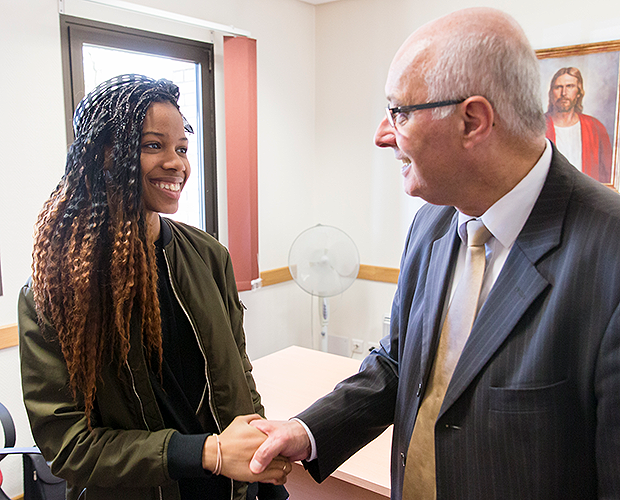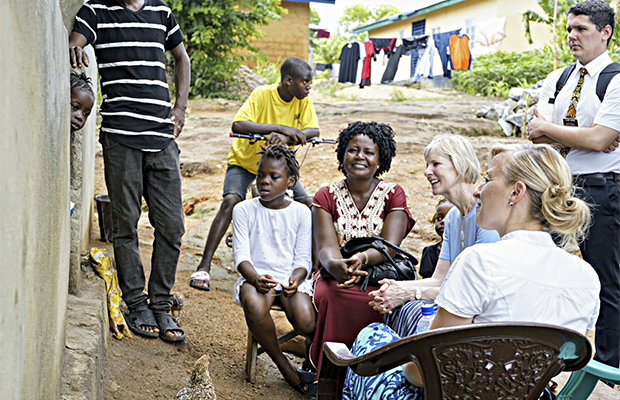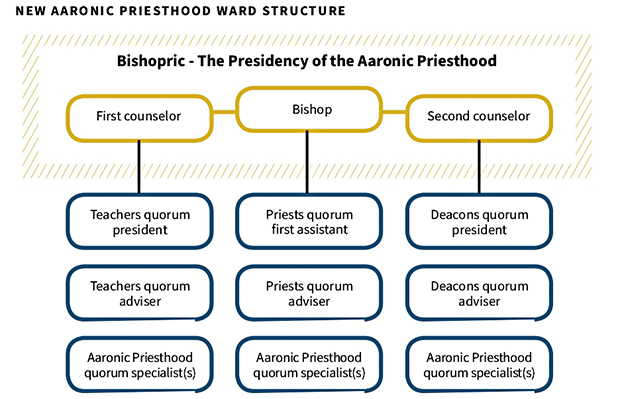Bishops, Are You Overwhelmed? Here’s What Ward Leaders and Members Can Do to Help
Contributed By Sydney Walker, Church News staff writer

The bishop meets with young men. As President Russell M. Nelson emphasized in the last October general conference, the primary responsibility of a bishop is to care for the youth.
Article Highlights
- As the elders quorum and Relief Society presidencies take initiative and the bishop continues to delegate, he will be able to focus on strengthening youth.
- Members can trust that our ministering brothers and sisters have been called and assigned by God to help us.
President Russell M. Nelson said in the last October general conference that the bishop’s “first and foremost responsibility” is to care for the youth of his ward.
As Elder Quentin L. Cook of the Quorum of the Twelve Apostles announced organizational changes to make youth a more significant focus—which included dissolving ward Young Men presidencies—he said, “We are confident that more young men and young women will rise to the challenge and stay on the covenant path because of this laser-like focus on our youth.”
But for a bishop who has a plate full of responsibilities, this “laser-like focus” on the youth might be easier said than done.
Many bishops initially felt overwhelmed in response to these organizational changes. Some bishops wondered how they would be able to manage all of their ward duties—duties that seemed to increase with the thought of releasing the ward Young Men presidencies.
“The concern many bishops have is that without a Young Men presidency, they are going to be saddled with extra responsibility. That isn’t the truth,” said Stephen W. Owen, Young Men General President.
“A bishop has always been the president of the Aaronic Priesthood. He still is. And he is still going to have the same number of adult leaders involved. The purpose is to bring the youth closer to the bishop.”
Though much is expected of bishops, they are not alone as they serve the ward. As the elders quorum and Relief Society presidencies take initiative and the bishop continues to delegate, he will be able to focus on strengthening youth—the rising leaders of the next generation.

As President Russell M. Nelson emphasized in the October general conference, the primary responsibility of a bishop is to care for the youth.
What Elders Quorum and Relief Society Presidencies Can Do: Engage in the Work of Salvation
When Jean B. Bingham, Relief Society General President, visited Sierra Leone in June, she met a woman named Mariatu Songo, who was serving as a Relief Society president. Sister Bingham noticed that as she walked with her from home to home in the village, everyone knew her. Sister Songo seemed to know all of the concerns of those families.
“She knew these people so well, and she was working to meet their challenges. She was ministering to everyone. She was caring for those in need. She was reaching out to the elderly,” Sister Bingham said. “I don’t believe that any of those people were taking a great deal of the bishop’s time, because she was taking that responsibility herself.”

President Jean B. Bingham, middle right, sits next to Mariatu Songo, a ward Relief Society president, middle left, in Sierra Leone in June 2019.
This sister is an example of a Relief Society president who is actively engaged to help relieve the load of the bishop and bless the ward, President Bingham said.
In a notice to stake and ward leaders dated October 6, 2018, it was stated that the responsibilities of member missionary work and temple and family history work in the ward should be delegated to the elders quorum and Relief Society presidencies. Elders quorum and Relief Society presidencies should also oversee ministering efforts.
Elder Craig C. Christensen, a General Authority Seventy and Utah Area President, said, “As directed by the First Presidency last October, quorum and Relief Society presidencies need to take primary responsibility for the work of salvation in the ward while working under the keys of the bishop.”
“This has to be done so bishops can relinquish much of the day-to-day responsibility they feel to minister to families and to move the work forward and focus the majority of their efforts on the youth,” he said.

The youth are the bishop’s primary responsibility. While the elders quorum and Relief Society presidencies can help with ministering, temple work, caring for those in need, family history, and missionary work, there are some responsibilities the bishop cannot delegate, such as being a common judge, fast offerings, and finances. Graphic courtesy of Church News.
Coordination between the elders quorum and Relief Society for ministering, missionary work, and temple and family history work is key, President Bingham said.
“But don’t wait to start,” she added. A Relief Society presidency could start with these questions: “How can we reach out and better minister to our sisters? What can we do to help each other be better missionaries? What can we do to help sisters get to the temple more often? How can we help them become more comfortable with doing family history?”
Once specific ideas are gathered, coordinate with the elders quorum for ideas that can be most effective at the ward level.
Ward council is another place to coordinate those ideas and keep all organizations informed. President Bingham said she knows of ward councils that focus on ministering two weeks of the month, missionary work one week, and temple and family history work another. “You’re not having any extra meetings that way,” she said.
Another way the elders quorum and Relief Society presidencies can help relieve the load of the bishop is by helping more with welfare. According to the Church’s Handbook 2, “Welfare is central to the work of the elders quorum and the Relief Society.” While the bishop oversees financial assistance and the use of fast offerings in the ward, elders quorum and Relief Society presidencies can work with families to teach principles of self-reliance and address welfare concerns.
Elders quorum and Relief Society presidencies can also take a greater role in counseling with the adults in their ward. Employment, budgeting, or challenges with family relationships are a few examples.
“Rather than starting with the bishop, members need to learn to start with the Relief Society and elders quorum presidency,” President Bingham said.
Elders quorum and Relief Society presidencies should take initiative to reach out, identify the problems, and step up to help “rather than allowing people to feel like they need to go to the bishop with every concern,” Elder Christensen said.
And the bishop has to learn how to refer those who come to him to the elders quorum and Relief Society presidents—even with some of the issues that may be sensitive, he added.
“There are certain worthiness issues that the bishop has to engage in. But even with permission from the person, he can involve others. To me, this is quite a cultural change from what we have established over many, many years,” Elder Christensen said.
To bishops who may struggle to delegate, President Bingham said: “Sometimes, as leaders, we often think we have to do it all or that no one else can do it as well. But once we are willing to give up a little bit of that control, we find it is such a blessing because it helps others grow as well.”
As the bishop develops leaders in his ward by delegating to the elders quorum and Relief Society presidencies, he is establishing a pattern for adult youth leaders to follow to learn how to delegate to the youth. This will help youth become leaders as well, she said.
What Young Women Presidents and Aaronic Priesthood Quorum Advisers Can Do: Develop Youth Leaders
One of the desired outcomes for the organizational changes for young men and young women announced in the October general conference is to help youth become converted and lead, President Owen said.
“What are we looking for at age 18?” President Owen asked. “We're looking for young women and young men who are converted to the gospel of Jesus Christ who will be able to leave home, have it in their heart, and continue on that path.”
But if the bishop is too occupied with the adults, the youth won’t be on his radar.
“The youth need a bishop in their lives. I needed a bishop in my life when I was growing up,” President Owen said. “If the bishop will spend time with the youth, the youth are going to want to go see the bishop when they have a struggle and need to turn heavenward.
“I can think of many situations where I know a youth-oriented bishop and you can see the youth rise up and follow the covenant path.”
President Owen said the changes to the Young Men organization allow the bishop to work directly with the young men and strengthen them one on one. Previously, it was hard for the young men to lead when they had a Young Men president and advisers that might have “taken over” for them.

The bishop has a scriptural duty to preside over the Aaronic Priesthood (see Doctrine and Covenants 107:15). To align with this revelation, ward Young Men presidencies have been discontinued. This change allows the bishop to be directly linked to the young men. Graphic courtesy of Church News.
Though the ward Young Men presidency no longer exists, the number of adult leaders for young men has not decreased, President Owen explained.
Each quorum has an adviser to support the bishop in his scriptural duty to preside over the Aaronic Priesthood as well as mentor young men as they serve in quorum presidencies. To allow “two-deep leadership” in each quorum, a long-term specialist can also be called. Other specialists can be called on a short-term basis for big events such as a camp, youth conference, or trek.
“Each of these adult leaders plays an essential role in lifting the young men and supporting the bishop in his duty,” President Owen said.
Bonnie H. Cordon, Young Women General President, said the change to allow the Young Women president to report directly to the bishop rather than to a bishop’s counselor is an opportunity for the young women to be closer to the bishop as well.
“As the bishop and Young Women president counsel together,” President Cordon said, “she can mentor and guide class presidencies as they do their part to sustain and support the bishop and serve ward members.”
Class and quorum presidencies can be “active contributors” as they participate in the “renamed and revitalized” ward youth council.
“As we engage class and quorum presidencies, we add over a dozen young capable leaders who are ready and willing to help the entire ward,” she said. “As we allow them to fulfill their callings, they will begin to minister to one another and strengthen the ward—which will alleviate the load of the bishop.”
Under the direction of the bishop, youth 14 and older may also be given the assignment to help build unity and belonging within a ward by participating in ministering. “Young women make great ministering companions to Relief Society sisters,” President Cordon said, just as young men are helpful as companions to brethren in Melchizedek Priesthood quorums.
Young Women presidents can also take a stronger role in counseling with young women who need an extra listening ear, she added. Leaders should always invite youth to meet with the bishop on matters of worthiness or abuse. They should also turn youth to their parents to “strengthen those eternal bonds.”
What Members Can Do: Trust
Elder Paul B. Pieper, General Authority Seventy and Southwest Area President, said in order for the restored Church to become what the Lord wants it to become, members need to believe in the structure He has given and where He has placed His keys.
“The ward structure will help the Church move forward and protect the Saints as we continue to move to this home-centered, Church-supported focus,” Elder Pieper said. “It’s not a new structure—we just haven’t used it very well. But we need to learn it. To me, it’s a big mindset change we’ve got to go through as members,” he said.
This mindset change, he said, includes two things: first, trusting ministering brothers and sisters; second, trusting elders quorum and Relief Society presidencies. Relying on them instead of the bishop will help relieve his load.
In April 2018, members of the Church were called to minister in “a higher and holier way.” One of the biggest challenges members have reported to Elder Pieper is when they visit those to whom they minister and ask, “What can we do to help?” the response usually is: “Nothing. We’re good.”
“We need to trust that our ministering brothers and sisters have been called and assigned by God to help us,” he said. “We have to believe that’s the Lord’s first line reaching out to us. We need to use them.”
Members shouldn’t be afraid to counsel with them when they have challenges or to call on ministering brothers for blessings. Ministering brothers and sisters also need to learn how to better understand the needs of those they minister to.
“We’ve got to have ears to hear and eyes to see their needs,” Elder Pieper said. “We all have needs. . . . I think this is part of the ‘higher and holier way’—learning how to have deeper, sweeter relationships where we can connect and support each other in newer and better ways.”
If the ministering brothers and sisters don’t have the necessary tools to help, they can call on a member of the elders quorum presidency or Relief Society presidency.
Remember, Elder Pieper said, the elders quorum president has priesthood keys, and when the Relief Society president is set apart, she has “parallel authority.”
“They can both be magnified in the same ways as bishops can to help meet the needs of the members,” he said. “You don’t need to go to the bishop to access that priesthood power.
“However, the bishop is set apart as the judge in Israel, and we should seek him out if there is something in our life that would affect our good standing as a member of the Church,” he added.
What should motivate members to trust more in their ministering brothers and sisters and elders quorum and Relief Society presidencies? Elder Pieper asked. The future of their children and youth.
“I think as adults, we need to be very, very sensitive that we might be one of the causes of the youth of the Church struggling,” he said. “Because we are the ones taking the time of the person who holds the keys for them.”

A bishop meets with a young woman. As President Russell M. Nelson emphasized in the last October general conference, the primary responsibility of a bishop is to care for the youth.

Though much is expected of bishops, they are not alone as they serve the ward. As the elders quorum and Relief Society presidencies take initiative and the bishop continues to delegate, he will be able to focus on strengthening the youth. Graphic courtesy of Church News.
